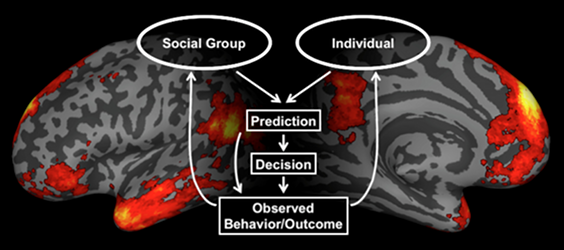

Damian A. Stanley
Email:
dstanley @ caltech.edu
Manuscripts in preparation / Under revision
Stanley, D., Stanley, J., Piech, R., & O’Doherty, J. (in prep). Distinct neural contributions to observational learning derived from facial expressions versus words.
Stanley, D., Rosenthal, I., Hutcherson, C., McNamee, D., Adolphs, R., O’Doherty, J. (in prep). Impaired Theory of Mind in autism may arise from impaired learning of others’ intentions.
Stanley, D., Spunt, R., Adolphs, R. (under revision) Towards a model-based neuroscience of how we represent other people.
Publications
Stanley, D. (2016). Getting to know you: specific neural computations for learning about people. Social, Cognitive, and Affective Neuroscience. pdf
Birmingham, E., Stanley, D. (corresponding and joint first author), Nair, R., & Adolphs, R. (2015). Implicit social biases in people with autism. Psychological Science. pdf
Stanley, D. & Adolphs, R. (2013). Toward a neural basis for social behavior. Neuron, 80(3): 816-826. pdf
Stanley, D., Sokol-Hessner, P., Fareri, D., Perino, M., Deglado, M., Banaji, M., & Phelps, E. (2012). Race and Reputation: Perceived racial group trustworthiness influences the neural correlates of trust decisions. Philosophical Transactions of the Royal Society B: Biological Sciences. 367:744-753 pdf
Stanley, D., Sokol-Hessner, P., Banaji, M., & Phelps, E. (2011). Implicit race attitudes predict trustworthiness judgments and economic trust decisions. Proceedings of the National Academy of Sciences, 108 (19) 7710-7715. pdf
Stanley, D., Sokol-Hessner, P., Banaji, M., & Phelps, E. (2011). Reply to Krueger: Good point, wrong paper. Proceedings of the National Academy of Sciences, 108(32) E411 pdf
Ferneyhough, E., Stanley, D., Phelps, E., & Carrasco, M. (2010). Cuing Effects of Faces are dependent on handedness and visual field. Psychonomic Bulletin & Review. 17(4):529-535 pdf
Stanley, D., Ferneyhough, E., & Phelps, E. (2009). Neural perspectives on emotion: Impact on perception, attention and memory. In the Handbook of Neuroscience for the Behavioral Sciences, Ed. Berntson, G.G. & Cacciopo, J.T., John Wiley and Sons pdf
Stanley, D., Phelps, E., & Banaji, M. (2008). The neural basis of implicit attitudes. Current Directions in Psychological Science. 17(2):164-170. pdf
Heller, R., Stanley, D., Yekutieli, D., Rubin, N. & Benjamini, Y. (2006). Cluster-based analysis of fMRI data. NeuroImage 33, 2, 599-608 pdf
Stanley, D. & Rubin, N. (2005). Rapid detection of salient regions: Evidence from apparent motion. Journal of Vision 5, 690-701. pdf
Stanley, D. & Rubin, N. (2003). fMRI activation in response to illusory contours and salient regions in the human Lateral Occipital Complex. Neuron 37, 323-331. pdf
Epstein, R., Harris, A., Stanley, D. & Kanwisher, N. (1999). The parahippocampal place area: recognition, navigation, or encoding? Neuron 23, 115-125. pdf
Kanwisher, N., Stanley, D. & Harris A. (1999). The fusiform face area is selective for faces not animals. NeuroReport 10, 183-187. pdf
Conover, S., Berkman, A., Gheith, A., Jahiel, R., Stanley, D., Geller, P., Valencia, E. & Susser, E. (1997). Methods for successful follow-up of elusive urban populations: An ethnographic approach with homeless men. Bull. N.Y. Acad Med. 74(1): 90–108. pdf